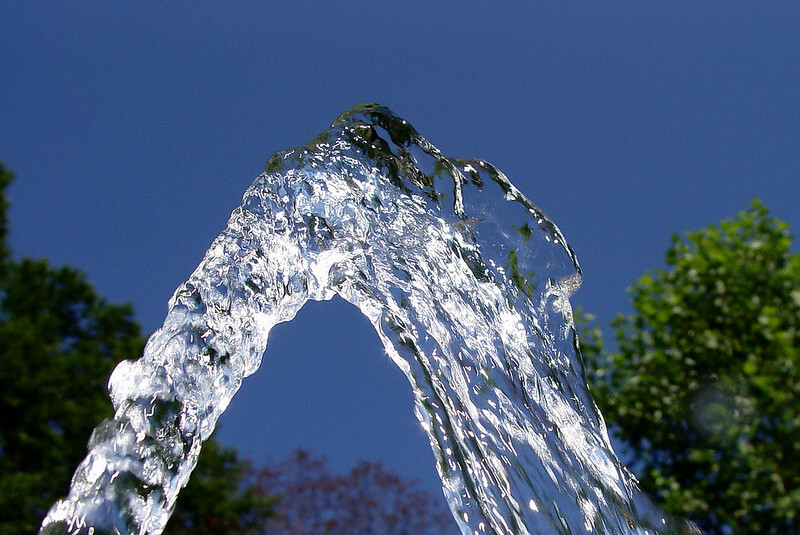
There are many factors that affect how long you should water your landscape. Scott Robinson, Flickr.
How long should you water the plants in your landscape: your trees, shrubs, perennials and lawn? There are many factors that go into watering correctly, and every landscape situation is unique and different. (We are not addressing annuals and vegetable gardens, both of which require frequent water.)
Factors to consider
Plant canopies and sun exposure
Plants under trees or shrubs that offer shade will need less water, while those exposed to the sun, especially the hot afternoon sun, will need more water.
Property microclimates
Perhaps you have an area that is more exposed to the wind. That will dry out plants sooner.
Types and depth of soil
Sandy soils won’t hold water as long as clay soils. Soil that has been amended over the years, so it is deep and rich, will hold more water than shallow soil.
Organic mulch layers
Mulch insulates the soil, so plants need less frequent water. We recommend adding a few inches of mulch to landscape beds every year. In addition to reducing water needs, mulch also feeds the beneficial organisms in the soil, which improves plant health. And it greatly reduces weeds.
Read our blog post “Add mulch now to reduce summer water needs.”
Irrigation efficiency
The efficiency of your watering system also affects how long you need to water. Every type of sprinkler or sprinkler system has certain advantages and disadvantages when it comes to efficiency. Our video on watering systems shows some options for wands, hoses and sprinklers.
Other factors contributing to water efficiency include weather temperatures, wind and soil readiness (i.e., does the soil already have some moisture in it or is it completely bone-dry).
Maturity of plants
Anything that has been newly planted, including trees, shrubs, lawns, perennials, grasses, vines, etc., needs to be watered regularly for the first two or three growing seasons so it can establish a strong root systems. Mature plants will need less water.
How to water newly planted trees
If you planted any trees this year, or within the last two years, a watering bag (or Tree Gator) is a convenient way to water your trees slowly and deeply. Watch this video from our YouTube playlist Watering Your Lawn and Garden to find out how to use a Tree Gator.
How long should you water? Depends on plant type
Lawns
Lawns will need more water than drought-tolerant ground covers. For lawns, you should aim to water one to two inches a week during the entire growing season from May to October. Don’t allow your lawn to go dormant. A weak, thin lawn is vulnerable to invasion of weeds, moss and insect pests.
Here is more info on how to water your lawn to keep it healthy. And here is a video on how to measure if you have watered one inch.
Trees
As summers get hotter and drier, we are recommending that people water their trees occasionally. We have seen drought stress in many of our clients’ trees. This can eventually kill the tree.
It takes a while to water a tree. You may need to run a soaker hose or drip irrigation system a few hours for the water to penetrate deeply into the root zone. You won‘t be able to water deeply enough with a hose or sprinkler.
Here is a blog post on how to water your trees.
Shrubs, grasses and perennials
How long to water these types of plants depends on their drought tolerance and location in the yard. See above.
Water slowly and deeply
The most important tip for all watering is to water slowly so the water penetrates deeply. This encourages plants to develop deep roots, making them more drought-tolerant. Frequent, shallow watering encourages plants to develop roots near the surface. They will tend to wilt at the first sign of hot weather.
Watch our short video Watering 101: Create Strong and Healthy Plants. It explains how and why to water deeply. Watering deeply is key to helping plants develop resilience.
When should you water?
There are a few general rules.
Water when it is cool. This makes perfect sense. If you try to water in the heat of the day, most of the water will evaporate into the air before it has a chance to get to the soil.
Mornings are the best time to water. The day is cool, the wind is usually not blowing and water has a chance to percolate into the soil profile before it warms up.
The next best time is early evening after the day begins to cool. Be aware that watering in the evening can promote some diseases. If you water in the evening, start in a shady area for less evaporation from the sun.
If the day is cloudy, any time during the day will be ok. The key is to get as much water into the soil profile as possible for plants to use with minimum waste from evaporation.
If your plants are showing water stress, water them immediately. Do not wait for the perfect time. If the plant is struggling, this moment is the perfect time.
Resources
Our YouTube playlist on Watering Your Lawn and Garden has several videos on the basics of watering, watering systems, watering new plants and trees, and more.
We have written many blog posts about watering. Here are links to a selection of posts. You can also find posts about specific watering topics by searching “watering.”
- Why you need to water your landscape
- Lawn and landscape watering: 8 quick tips
- Don’t forget to water your trees
- How to water for a Bee Friendly Lawn
- Gardening and climate change
- How to use mulch in your yard
Photo: Scott Robinson, Flickr.
